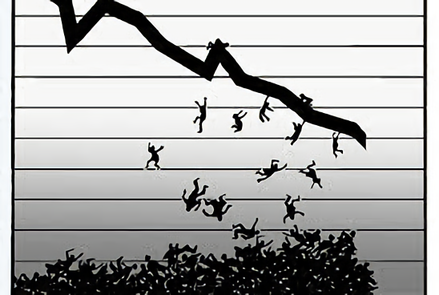Nature of Financial Crisis – 3rd Chapter

THE GREAT DEPRESSION
The Great Depression is the name given to the economic depression that began in 1929 (but had its effects only in the late 1930s) and continued throughout the 1930s. Although the Depression centered on North America and Europe, it had devastating effects on the rest of the world (especially in the industrialized countries). The crisis of 1929 was the cause of unemployment, economic contraction, and stagnation, which was unprecedented until then. The foundations of new trends in the economy were laid due to this crisis. The Great Depression hit most industrialized cities, creating an army of unemployed and homeless in these cities. Construction activities ceased in many countries affected by the crisis; The 40-60% decline in agricultural product prices adversely affected farmers and rural populations. The mining area was one of the sectors most affected by the depression due to the unexpected decrease in demand. The Great Depression ended in different countries on different dates.
- Causes of the crisis
After taking a look at the atmosphere before the big crisis, it is necessary to dwell on the causes and development of the crisis. As is the case with many events affecting the world, many studies and different comments have been made on the causes of this event, but we can list a few common reasons in general: First; It was the financial power of companies in America. In the 1870s, when there were many large and small companies in America, small companies had to merge in the face of the difficulties brought by the First World War and established monopolies after the war. So much so that by 1929, the holding that had a say over 50% of the American economy their number was about 200. This showed that the bankruptcy of even a single holding would be enough to shake the economy. A second reason was that the banks were poorly structured. There were no laws determining the capital principles, reserve, and loan rates of banks. For example, there were no laws ensuring the reliability of companies’ financial statements. Therefore, the investor could not have enough information about the company from which he bought the bill. Again, there were no laws separating commercial banks from investment banks.
1994 TURKEY CRISIS
By the beginning of 1994, the largest current account deficit and public deficit in the history of the Republic are sufficient to see the extent of macroeconomic imbalances. These structures and policies, which could not be sustained in the medium-long term, are the reasons for the severe economic crisis in April 1994.
- Developments that Caused the Decisions of April 1994
The examination of the period between the last months of 1993, when the crisis signals began to be received, and April 199, shows that quite wrong practices were resorted to in terms of the management of the crisis. with excessive speculative capital inflows of economic balances which have a negative impact on Turkey experienced severe as some developing countries are taken together with the emergence of the crisis in the measures we have been able to overcome the crisis lighter. However, applications and economic decisions that are referenced in Turkey have created an increasing effect on the size of the crisis could be called. In other words, the period spanning late 1993 and early 1994 in Turkey, has been unsuccessful in managing the crisis. In mid-1993, the political authority started to announce that the public interest burden was very high and that policies to be implemented in the short term would aim to lower interest rates. At this stage, liquidity began to be injected into the economy, but high liquidity and expected declining foreign exchange demand began to increase rapidly. On the other hand, the high current account deficit also provoked devaluation expectations and increased the foreign exchange demand.
1997 ASIA CRISIS
The most important financial event of recent years is the financial crisis seen in Southeast Asia and affecting all world economies. The financial crisis, which started in February 1997 and spread to the regional economies and the world with Thailand’s devaluation of the currency baht on July 2, is seen as an important economic event in various aspects. The fact that such a crisis could not be predicted and that there were no problems in the real economies of the countries suffering from the crisis brought both the management and control of the international financial system and speculative capital movements, which played an important role in the crisis, on the agenda (Akdiş, 2004). Although the South Asian crisis started in Thailand, it spread to Malaysia, Indonesia, Singapore, and the Philippines, which are named as “ASEAN-5” along with Thailand. As a result of the rapid depreciation of the baht, a wave of devaluation started in the countries of the region that tried to keep the value of their money in a controlled manner (Canpolat, 2004; 57). Baht lost 16% on July 2, 1997, Won 41% between December 4 and 23, 1997, Korean Composite Index lost 50%, Rupiah fell 71% between December 1, 1997 and January 26, 1998, and the Jakarta Composite Index between September 10-December 15, 1997. Between 41%, Ringgit 25% in December, and Kuala Lumpur Composite Index lost 45% between 10 September 1997-12 January 1998. Due to these depreciations, in the first period of the crisis, there was a large and rapid decline in the credit ratings given by the rating agencies to the countries in the region. Looking at the credit ratings given by Moody’s, Standard & Poor’s, and Fitch Rating rating agencies, Thailand’s credit rating decreased by 4, Indonesia’s credit rating by approximately 5, South Korea’s credit rating by more than 9 levels (Öztürk, 2003; 174). With the fixed exchange rate system applied by Southeast Asian countries to enter into a crisis, the defects (deterioration of the quality of assets and liabilities) in the balance sheet structures of firms in the real sector and banks in the financial sector played an important role (Çolak, 2002; 158).
2008 CRISIS
The process that started as a mortgage crisis in the USA in 2008 and became a liquidity crisis that spread to the whole world with the progressing has deeply shaken all world economies. The bottleneck the US economy has fallen into has narrowed the economies of all countries due to the US’s position as a customer of every country. The US bank named Bear Stearns sold the entire company to JP Morgan at a price of $ 2 per share, much lower than its value set at $ 236 million in March. However, this bank was known as the largest bank in the USA. The market value of the company in January 2007 was determined as 20 billion dollars. When it became apparent that it would go bankrupt upon the withdrawal of $ 17 billion in two days from Bear Stearns, the Fed left the options to sell or go to the bankruptcy desk to prevent the bankruptcy from spreading to the entire system. The Fed has stated that it will not help Bear Stearns if the company is not transferred to JP Morgan. Bear Stearns officials were also forced to transfer the shares to JP Morgan for $ 2, despite their announced book value of $ 84 per share.
CONCLUSION
Economic activities have been following daily, monthly, seasonal and annual rhythms since their inception. Agricultural production gains importance as long as no techniques are used to prevent the effect of unpredictable changes in weather conditions and equally depends on coincidences. Thus, from the beginning of agricultural activities to the beginning of the 19th century, many industrialized countries of today have experienced a very special type of crisis called the “grain crises”. Drought caused famine, hunger, and price increases, especially by rapidly decreasing grain production. Income from agriculture decreased; It also brought about a contraction in economic activities. This is a kind of underproduction crisis. Such crises have been an important feature of farming communities where primitive technologies are used. With the industrial revolution, the effect of nature on economic activity has decreased compared to the past. However, economic life continued to be affected by the crises. This turmoil in economic activities drew the attention of some thinkers to crises. Thus, this interest, which started with Juglar, developed with Schumpeter, Kondratieff, and Marx, and continued until Keynes and Monetarists, contributed to the formation of an important archive on economic crisis theories. Each author and school have adopted different approaches in explaining the real economic crisis. The relative growth and stability phase experienced in the economic conjuncture in the period between 1940 and 1970 brought a pause in the discussions on crisis theories. However, with the collapse of the BW system and the impact of oil shocks in the early 1970s, the conjuncture changed direction again. On the other hand, the financial globalization trend that spread rapidly to the whole world in the 1980s under the leadership of the USA and England opened the door to financial crises and currency crises became a type of crisis that is frequently encountered. It is generally accepted that countries in a financial globalization effort make many mistakes in ranking and pace, and this situation leads to financial crises and monetary crises. However, in this new period, many authors have turned their attention from real economic crises to monetary crises and the researchers have created a relatively new archive to explain the monetary crises. In real economic crisis theories, the same kind of crises are explained in different ways by different authors and schools, while the situation is slightly different in models of money crises. Of course, some monetary crises have also been explained in different ways by different authors, but the archive formed to explain such crises is basically not fed by these differences. The basis of the archive can be explained as follows: Money crises have been handled in the literature from many different aspects. Studies on the explanation of such crises first started with the pioneering work of Krugman (1979). The debt crises of the 1980s in the period from that date to the present; 1992–93 European Monetary Mechanism; 1994 Mexico; 1997–98 South East Asia; Each of the Russia and Brazil in 1998 and Turkey in 2001 and the Argentine crisis, others with common properties but sometimes exhibited much different. On the other hand, each new crisis has been based on more or less different reasons than the previous ones and occurred in different economic environments. This has partially or totally inadequate or invalidated existing models that claim to explain currency crises in each new crisis. All these developments have revealed new and different views to explain the money crises, and this process has enabled, in parallel with itself, to develop new models for explaining the money crises. Today, compared to the relatively stable economy of the 1800s, there is an economic world that changes and develops much faster and suddenly. In today’s economy, where there are no economic boundaries, at least financially, the attention is focused on financial crises rather than real ones. Understanding the crisis of yesterday and today in such a rapidly changing financial structure open to all kinds of speculation is one thing. However, due to the nature of the economy, it does not provide absolute protection to know now the probable crisis of tomorrow.
Zeki Talustan Gülten
References:
Öztürk, S. (2003). Sabit Döviz Kuru Politikasının Krizlere Olan Etkisi: 1997 Güneydoğu Asya ve 2000 Kasım-2001 Şubat Türkiye Krizleri. Yönetim ve Ekonomi: Celal Bayar Üniversitesi İktisadi ve İdari Bilimler Fakültesi Dergisi, 10(1), 171-185.
Çolak, Ö. F. (2002). Finansal Kriz Sürecinde Türk Bankacılık Sektörünün Durumu ve Sektörün Yeniden Yapılandırılması. Kriz ve IMF Politikaları, 155-176.
Akdiş, M. (2004). Sermaye Hareketleri Finansal Krizler ve Türkiye. makdis. pamukkale. edu. tr/Nazilli1. ppt>(10.10. 2006).
Canpolat, N. (2004). Merkez Bankası Yüzmekten Korkuyor Mu?. İktisat İşletme ve Finans, 19(220), 76-85.



